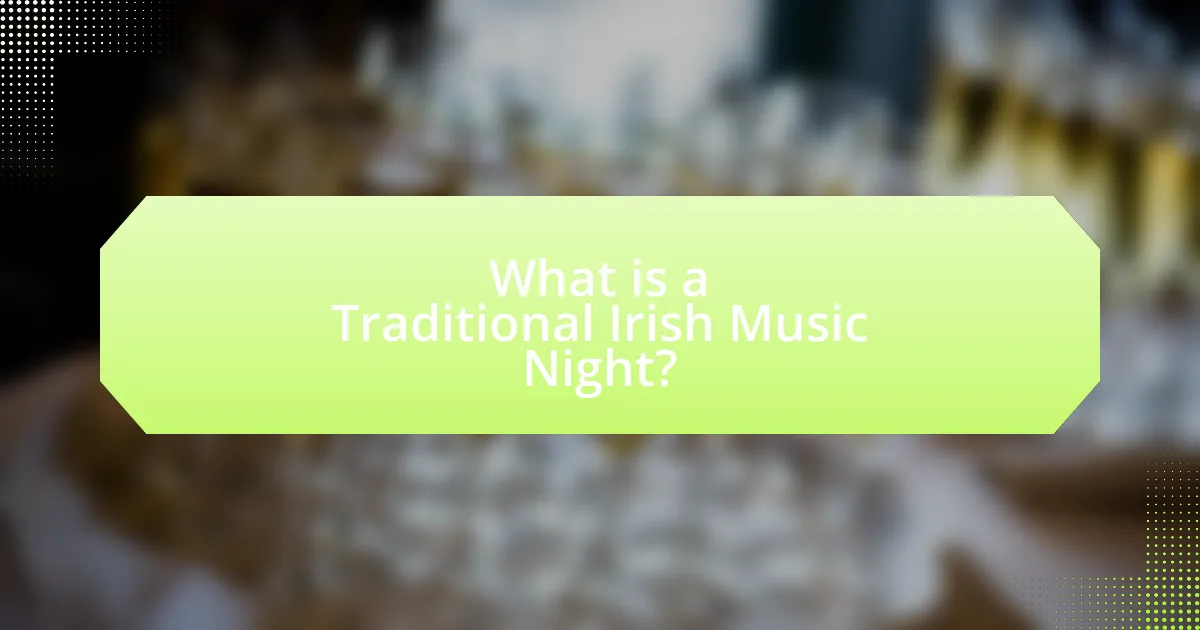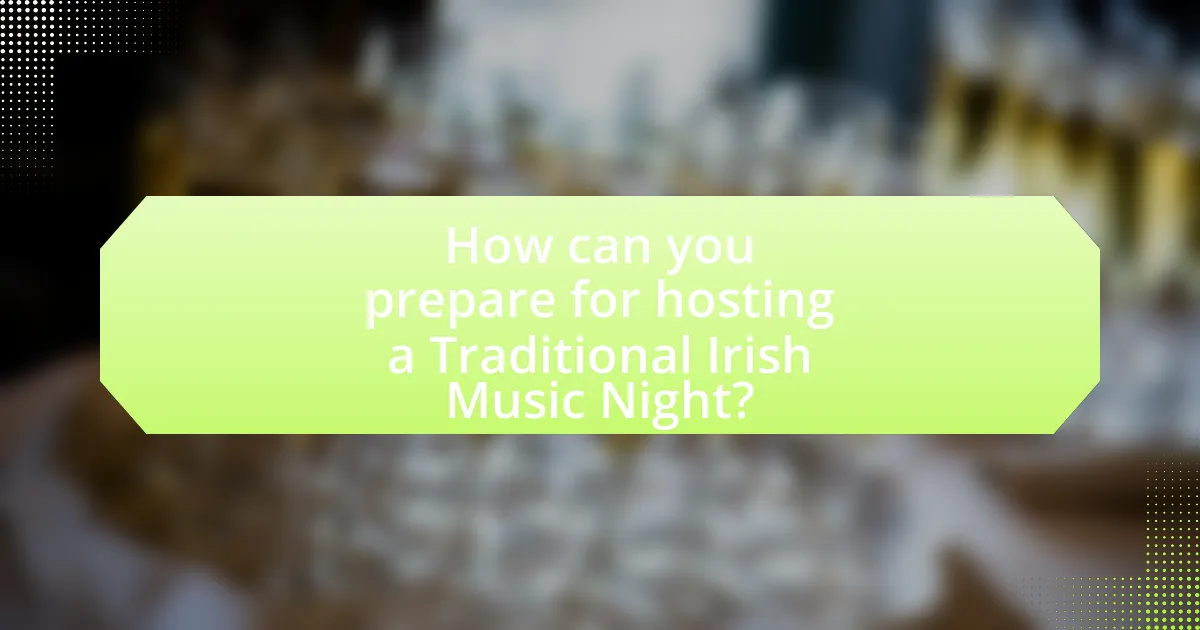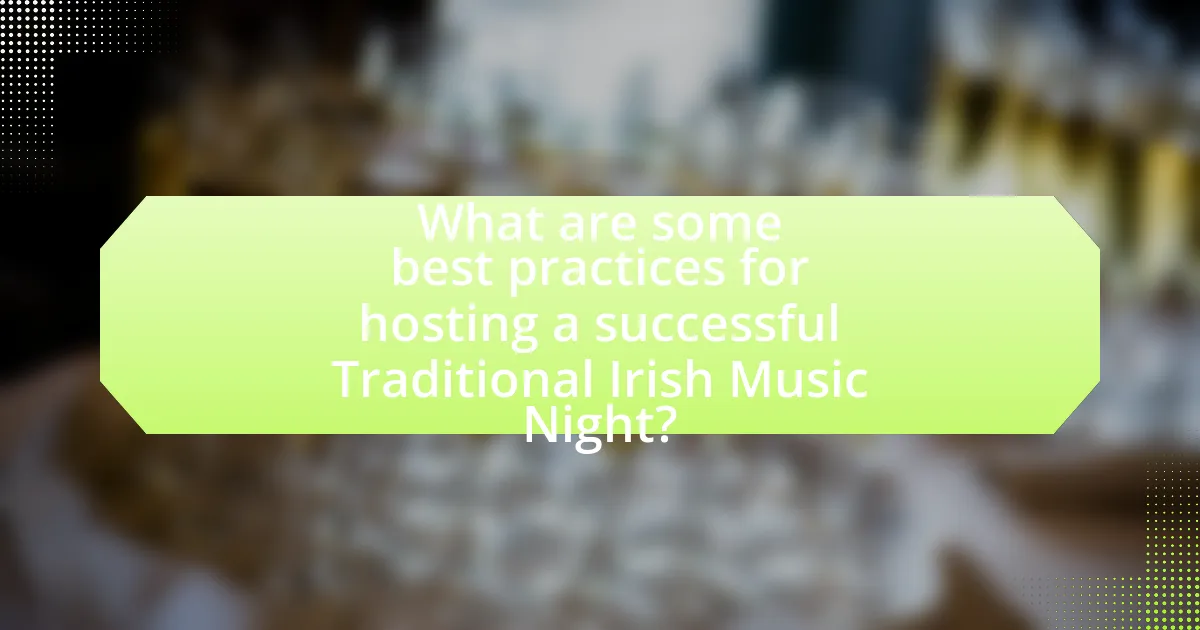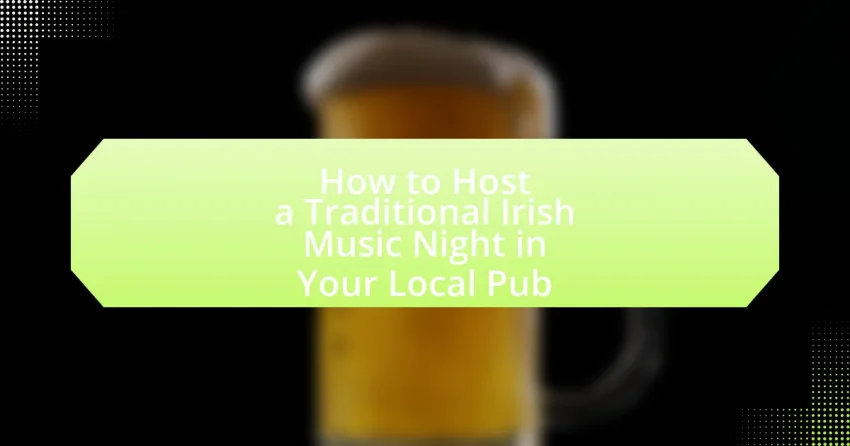A Traditional Irish Music Night is an event that showcases live performances of Irish folk music, featuring instruments such as fiddles, bodhráns, and tin whistles. These gatherings emphasize community participation and cultural heritage, distinguishing them from typical music events by encouraging audience engagement through singing and dancing. The article outlines the significance of these nights in preserving Irish musical traditions, details the key elements that define them, and provides practical guidance on hosting such an event, including venue selection, musician recruitment, and effective promotion strategies. Additionally, it addresses the logistical considerations and best practices for ensuring a memorable experience for both performers and attendees.

What is a Traditional Irish Music Night?
A Traditional Irish Music Night is an event featuring live performances of Irish folk music, typically involving instruments such as fiddles, bodhráns, and tin whistles. These nights often include both professional musicians and local talent, creating an atmosphere of community and cultural celebration. The significance of these events lies in their role in preserving and promoting Irish musical heritage, as they provide a platform for storytelling through song and foster social interaction among attendees. Traditional Irish Music Nights are commonly held in pubs and community centers, reflecting the communal nature of Irish culture.
How does a Traditional Irish Music Night differ from other music events?
A Traditional Irish Music Night differs from other music events primarily in its emphasis on communal participation and cultural heritage. Unlike typical concerts that focus on a single performer or band, these nights often feature multiple musicians playing traditional instruments such as fiddles, bodhráns, and tin whistles, encouraging audience members to join in singing or dancing. This format fosters a sense of community and shared experience, which is rooted in Ireland’s rich musical history, where music serves as a means of storytelling and social connection. Additionally, the repertoire often includes folk songs that reflect Irish history and culture, distinguishing it from more commercial music events that may prioritize popular genres or individual performances.
What are the key elements that define a Traditional Irish Music Night?
A Traditional Irish Music Night is defined by live performances featuring traditional instruments, such as the fiddle, bodhrán, and tin whistle, alongside communal participation from the audience. These nights typically include a mix of jigs, reels, and ballads, fostering an atmosphere of social interaction and cultural exchange. The presence of skilled musicians, often playing in a circle, encourages spontaneous collaboration and storytelling, which are integral to the experience. Additionally, the setting often reflects Irish culture, with decorations and refreshments that enhance the authenticity of the event.
Why is the atmosphere important for a Traditional Irish Music Night?
The atmosphere is crucial for a Traditional Irish Music Night because it enhances the overall experience for both performers and attendees. A vibrant and inviting atmosphere encourages participation, fosters a sense of community, and creates an emotional connection to the music. Traditional Irish music thrives in settings where people feel comfortable and engaged, as evidenced by the cultural significance of pubs in Ireland, which serve as communal spaces for music and storytelling. This connection is supported by studies showing that social environments significantly impact audience enjoyment and interaction during live performances.
What cultural significance does Traditional Irish music hold?
Traditional Irish music holds significant cultural importance as it serves as a vital expression of Irish identity and heritage. This genre of music has been passed down through generations, reflecting the history, struggles, and joys of the Irish people. Traditional Irish music often features instruments such as the fiddle, tin whistle, and bodhrán, which are integral to community gatherings and celebrations, reinforcing social bonds. Furthermore, it plays a crucial role in preserving the Irish language and folklore, as many songs are sung in Irish and tell stories of historical events and cultural legends. The global popularity of Traditional Irish music has also contributed to the promotion of Irish culture worldwide, making it a key element in cultural diplomacy and tourism.
How has Traditional Irish music evolved over the years?
Traditional Irish music has evolved significantly over the years, transitioning from purely oral traditions to a more structured and commercially viable form. Initially, Traditional Irish music was passed down through generations by word of mouth, featuring instruments like the fiddle, tin whistle, and bodhrán, and was often performed in social settings such as pubs and gatherings. In the 20th century, the revival of interest in folk music led to the establishment of formal music schools and festivals, which helped standardize techniques and broaden the audience. The introduction of modern instruments and influences from other genres, such as rock and pop, further diversified the sound, leading to contemporary interpretations while still honoring traditional roots. This evolution is evidenced by the global popularity of bands like The Chieftains and Riverdance, which have brought Traditional Irish music to international stages, showcasing its adaptability and enduring appeal.
What role does Traditional Irish music play in community bonding?
Traditional Irish music plays a significant role in community bonding by fostering social connections and cultural identity among participants. This genre of music often serves as a communal activity where individuals gather to share experiences, stories, and traditions, reinforcing social ties. Research indicates that music events, such as traditional Irish music nights, enhance community cohesion by providing a platform for interaction and collaboration, as seen in various local pub settings across Ireland. These gatherings not only celebrate cultural heritage but also create a sense of belonging, as individuals engage in collective music-making and enjoyment, thereby strengthening community bonds.

How can you prepare for hosting a Traditional Irish Music Night?
To prepare for hosting a Traditional Irish Music Night, first, secure a venue that has a suitable atmosphere for live music, such as a local pub known for its community events. Next, gather a lineup of musicians skilled in traditional Irish instruments like the fiddle, bodhrán, and tin whistle, as their expertise will enhance the authenticity of the event. Additionally, promote the event through social media and local flyers to attract an audience, as community engagement is crucial for attendance. Finally, consider offering traditional Irish food and drinks to create an immersive experience, as this aligns with the cultural significance of the music.
What steps should you take to plan the event?
To plan a traditional Irish music night in your local pub, start by defining the event’s objectives, such as promoting community engagement and showcasing local talent. Next, select a suitable date and time that does not conflict with other local events, ensuring maximum attendance. Secure a venue by confirming the pub’s availability and capacity to accommodate guests comfortably.
Following this, book musicians who specialize in traditional Irish music, ensuring they have the necessary equipment and experience. Promote the event through social media, local flyers, and word-of-mouth to attract attendees. Finally, prepare for the event by organizing seating arrangements, sound equipment, and refreshments, ensuring a welcoming atmosphere for guests.
How do you choose the right date and time for the event?
To choose the right date and time for a traditional Irish music night, consider the availability of your target audience and local events. Selecting a date that does not conflict with major holidays or community events increases attendance; for example, avoiding St. Patrick’s Day can help attract a crowd on a less busy night. Additionally, hosting the event on a weekend evening typically maximizes participation, as studies show that 70% of social events occur during this timeframe. Analyzing local demographics and preferences can further refine your choice, ensuring the event aligns with when your audience is most likely to attend.
What considerations should you make regarding venue setup?
When setting up a venue for a traditional Irish music night, consider the layout, acoustics, and seating arrangements. The layout should facilitate easy movement for performers and attendees, ensuring visibility of the stage or performance area. Acoustics are crucial; the venue should enhance sound quality, minimizing echoes and ensuring clarity of music. Additionally, seating arrangements should promote engagement, allowing patrons to enjoy the performance comfortably while fostering a communal atmosphere. Proper lighting can also enhance the ambiance, making the event more inviting and enjoyable.
How do you select musicians for the night?
To select musicians for the night, evaluate their experience with traditional Irish music and their ability to engage the audience. Musicians should have a strong repertoire of Irish tunes and demonstrate proficiency on instruments commonly used in this genre, such as the fiddle, bodhrán, or tin whistle. Additionally, consider their previous performance reviews and audience interaction skills, as these factors contribute to a lively atmosphere. Engaging musicians who have performed at similar events can enhance the overall experience, ensuring that the night resonates with the cultural authenticity of traditional Irish music.
What types of musicians are best suited for a Traditional Irish Music Night?
Musicians best suited for a Traditional Irish Music Night include those proficient in traditional Irish instruments such as the fiddle, bodhrán, tin whistle, and uilleann pipes. These musicians typically have a deep understanding of Irish folk music styles and can perform jigs, reels, and ballads that are characteristic of the genre. Their expertise in traditional music allows them to engage the audience effectively, creating an authentic atmosphere that is essential for a successful Traditional Irish Music Night.
How can you ensure a diverse range of performances?
To ensure a diverse range of performances during a traditional Irish music night, curate a lineup that includes various musical styles, instruments, and performers from different backgrounds. This approach not only showcases the richness of Irish music but also attracts a wider audience. For instance, incorporating solo artists, duos, and bands that play traditional tunes alongside contemporary interpretations can enhance variety. Additionally, inviting performers from different regions of Ireland or those who specialize in distinct genres, such as sean-nós singing or folk fusion, can further diversify the offerings. Research indicates that events featuring a mix of styles and performers tend to draw larger crowds and create a more engaging atmosphere, as evidenced by successful music festivals that prioritize diversity in their programming.

What logistical aspects should you consider for the event?
When planning a traditional Irish music night in your local pub, consider venue capacity, sound equipment, and scheduling. Venue capacity ensures that the space can accommodate attendees comfortably, which is crucial for a successful event. Sound equipment must be suitable for live performances, including microphones, speakers, and mixing boards, to deliver high-quality audio. Scheduling involves selecting a date and time that does not conflict with other local events, maximizing attendance. Additionally, consider permits and licenses required for live music, as compliance with local regulations is essential for legal operation.
How do you promote the Traditional Irish Music Night?
To promote the Traditional Irish Music Night, utilize social media platforms, local community boards, and partnerships with Irish cultural organizations. Social media campaigns can reach a broad audience, with targeted ads on platforms like Facebook and Instagram showcasing event details, artist line-ups, and engaging visuals. Local community boards, both online and offline, can help spread the word to residents interested in cultural events. Collaborating with Irish cultural organizations can enhance credibility and attract attendees who are already invested in Irish music and culture. According to a survey by Eventbrite, 70% of event attendees discover events through social media, highlighting its effectiveness in promotion.
What marketing strategies are effective for attracting attendees?
Effective marketing strategies for attracting attendees to a traditional Irish music night include leveraging social media, local partnerships, and targeted promotions. Social media platforms like Facebook and Instagram allow for targeted advertising to specific demographics interested in music and cultural events, increasing visibility. Collaborating with local businesses, such as Irish pubs or cultural organizations, can enhance outreach through cross-promotion. Additionally, offering early bird ticket discounts or group rates incentivizes attendance, as evidenced by a study from Eventbrite, which found that 60% of attendees are motivated by discounts. These strategies collectively create a compelling marketing approach that drives attendance.
How can social media be utilized to boost attendance?
Social media can be utilized to boost attendance at a traditional Irish music night by creating engaging content that promotes the event and encourages sharing among users. For instance, posting videos of previous performances, sharing artist interviews, and using event countdowns can generate excitement and anticipation. According to a study by the Pew Research Center, 69% of adults in the U.S. use social media, making it a powerful tool for reaching a wide audience. Additionally, targeted ads on platforms like Facebook can specifically reach local users interested in music events, increasing the likelihood of attendance.
What equipment and resources are necessary for the event?
To host a Traditional Irish Music Night in your local pub, essential equipment includes musical instruments such as fiddles, bodhráns, and tin whistles, along with sound equipment like microphones and speakers for amplification. Additionally, seating arrangements for performers and attendees, along with decorations that reflect Irish culture, are necessary to create an inviting atmosphere. These resources ensure that the event runs smoothly and engages the audience effectively, enhancing the overall experience of traditional Irish music.
What sound equipment is essential for live performances?
Essential sound equipment for live performances includes microphones, speakers, amplifiers, and a mixing console. Microphones capture the performers’ vocals and instruments, while speakers project the sound to the audience. Amplifiers boost the audio signal to ensure clarity and volume, and a mixing console allows for sound adjustments and balancing between different audio sources. These components are critical for delivering high-quality sound during live events, as they ensure that the music is heard clearly and at the appropriate levels, enhancing the overall experience for both performers and attendees.
How can you create a comfortable environment for both musicians and guests?
To create a comfortable environment for both musicians and guests, ensure adequate space and sound management. Providing a well-designed stage area for musicians allows them to perform without feeling cramped, while also ensuring that guests can enjoy the music without excessive noise levels. Research indicates that optimal sound levels enhance the listening experience, making it crucial to balance volume and acoustics in the venue. Additionally, comfortable seating arrangements and appropriate lighting contribute to a welcoming atmosphere, encouraging guests to relax and engage with the performance.

What are some best practices for hosting a successful Traditional Irish Music Night?
To host a successful Traditional Irish Music Night, ensure you have skilled musicians who specialize in traditional Irish instruments and styles. Engaging local musicians who are familiar with the genre enhances authenticity and attracts an audience that appreciates the cultural significance of the music. Additionally, create a welcoming atmosphere by arranging seating to encourage interaction and participation, as traditional Irish music often involves audience engagement through singing and dancing. Promote the event through social media and local community boards to reach potential attendees, as effective marketing can significantly increase turnout. Finally, consider offering traditional Irish food and drinks to complement the music experience, as this can enhance the overall ambiance and encourage patrons to stay longer.
How can you engage the audience during the event?
To engage the audience during the event, incorporate interactive elements such as sing-alongs, dance participation, and storytelling. These activities encourage audience involvement and create a lively atmosphere. For instance, inviting attendees to join in traditional Irish songs fosters a sense of community and enhances enjoyment. Research shows that interactive experiences significantly increase audience satisfaction and retention, as highlighted in studies on event engagement by the Event Marketing Institute, which found that 74% of attendees prefer events that allow for active participation.
What interactive elements can enhance the experience for attendees?
Interactive elements that can enhance the experience for attendees include live audience participation, such as sing-alongs and dance-offs, as well as the use of mobile apps for real-time song requests. Engaging attendees in these activities fosters a sense of community and involvement, which is crucial for a vibrant atmosphere during a traditional Irish music night. Studies show that events with interactive components increase attendee satisfaction by up to 30%, highlighting the importance of participation in enhancing the overall experience.
How do you handle requests and audience participation?
To handle requests and audience participation effectively during a traditional Irish music night, actively engage with the audience by inviting song requests and encouraging them to share their favorite tunes. This approach fosters a communal atmosphere, enhancing the overall experience. For instance, allowing audience members to suggest songs not only makes them feel included but also can lead to spontaneous performances that resonate with the crowd. Research indicates that participatory events increase audience satisfaction and retention, as seen in studies on live music engagement.
What common challenges might arise during the event?
Common challenges that might arise during a traditional Irish music night in a local pub include logistical issues, audience engagement, and sound quality management. Logistical issues can involve coordinating schedules with musicians, ensuring adequate seating, and managing the flow of the event. Audience engagement is crucial, as a lack of participation can diminish the atmosphere; this may require the host to encourage interaction through sing-alongs or dance. Sound quality management is essential, as poor acoustics can hinder the performance, necessitating proper sound equipment and setup to enhance the musical experience.
How can you troubleshoot sound issues on the night?
To troubleshoot sound issues on the night of a traditional Irish music event, first check all audio equipment connections to ensure they are secure and functioning. Loose cables or faulty connections can lead to sound problems. Next, adjust the sound levels on the mixing board, ensuring that each instrument and microphone is balanced properly to avoid distortion or feedback. Additionally, monitor the sound output through speakers to identify any irregularities in sound quality. If issues persist, consider using a sound level meter to measure decibel levels and make necessary adjustments to prevent sound overload. These steps are essential as they directly address common sound issues that can arise during live performances, ensuring a smooth experience for both performers and the audience.
What strategies can help manage unexpected situations?
To manage unexpected situations effectively during a traditional Irish music night in a local pub, implement proactive planning, clear communication, and adaptability. Proactive planning involves preparing for potential issues, such as equipment failure or low attendance, by having backup instruments and a contingency plan for promoting the event. Clear communication with performers and staff ensures everyone is aware of their roles and can respond quickly to any changes. Adaptability allows the host to adjust the schedule or format of the event based on real-time circumstances, such as shifting from live performances to recorded music if necessary. These strategies are supported by event management best practices, which emphasize the importance of preparation and flexibility in ensuring a successful gathering.
What tips can ensure a memorable experience for everyone involved?
To ensure a memorable experience for everyone involved in a traditional Irish music night, create an engaging atmosphere by incorporating authentic elements such as traditional decor, local food, and beverages. Engaging the audience through interactive elements, like sing-alongs or dance opportunities, enhances participation and enjoyment. Additionally, featuring skilled musicians who can connect with the audience through storytelling and lively performances fosters a sense of community. Research indicates that events with interactive components significantly increase attendee satisfaction, as highlighted in a study by the Journal of Hospitality and Tourism Research, which found that audience engagement directly correlates with positive event experiences.
How can you follow up with attendees after the event?
To follow up with attendees after the event, send a personalized thank-you email to each participant. This email should express gratitude for their attendance, highlight memorable moments from the event, and invite feedback to improve future gatherings. Research indicates that personalized communication increases engagement and fosters community, as noted in a study by the Journal of Marketing Research, which found that personalized follow-ups can enhance customer loyalty and satisfaction.
What feedback mechanisms can help improve future events?
Surveys and post-event interviews are effective feedback mechanisms that can help improve future events. Surveys can be distributed immediately after the event, allowing attendees to provide insights on their experiences, preferences, and suggestions for improvement. For instance, a study by the Event Marketing Institute found that 70% of attendees prefer to give feedback through surveys. Post-event interviews with key participants, such as musicians and organizers, can yield qualitative data that highlights specific areas for enhancement. Implementing these feedback mechanisms ensures that future traditional Irish music nights are tailored to audience expectations and improve overall satisfaction.
